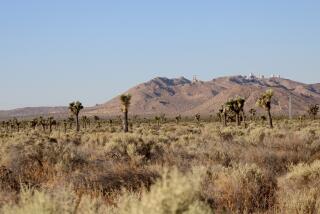Rare Squirrels Stand in Way of Observatory : Environment: Judge blocks construction on Arizona’s Mt. Graham after questions are raised about the survival of the species.
- Share via
TUCSON — Fear for the survival of 180 endangered squirrels atop an isolated mountain has led a judge to block the start of construction on what could become the world’s most powerful observatory.
U.S. District Judge Alfredo C. Marquez last week granted a four-month injunction barring the University of Arizona from beginning construction on the first two of at least three telescopes at the planned $200-million Mt. Graham International Observatory.
If all goes smoothly with the first two telescopes, a third device with the viewing power of a telescope more than 37 feet in diameter is planned for the mid-1990s.
The judge said serious questions had been raised about whether the construction would cause irreparable harm to the Mt. Graham red squirrel.
“I’m surprised. I’m encouraged,” said Dr. Robin Silver, a spokesman for the Maricopa County Audubon Society. “This has been a tough process all along. I’m encouraged that the system can still work.”
The university has decided to appeal, spokesman Steve Emerine said.
Mt. Graham in the Pinaleno Mountains in southeastern Arizona is the only known habitat for the 180 remaining squirrels.
In 1988, the U.S. Fish and Wildlife Service concluded in a biological report for the U.S. Forest Service, the site’s landlord, that the telescopes could coexist with the squirrel. Arizona’s congressional delegation then pushed through legislation ordering the Forest Service to grant the university a permit for construction.
But environmental groups sued, contending that perching the telescopes on an 8.6-acre site on one of Mt. Graham’s three peaks would cause the extinction of the 8-ounce squirrels by taking away more of the forested land they need to survive.
University officials contend that poor pine-cone crops in recent years have hurt the squirrel population. They said hunting, logging, use of off-road vehicles and Christmas-tree cutting have been stopped because of the planned observatory, and that 60 to 80 acres will be reforested.
In closing arguments, lawyers for the university and the Justice Department said that the congressional act precluded any further environmental review of the squirrel’s habitat in connection with the first three telescopes.
But Marquez said last week he had some questions about whether the wildlife service’s ruling was “preordained.”
He asked Justice Department lawyer Larry Bradfish, “What’s the harm of saying there are some very serious issues here and Congress, you have 120 days . . . why don’t you take another look at it?”
University officials said they are disappointed by the ruling.
U.S. Rep. Jim Kolbe (R-Ariz.) said he does not think Congress will take new action.
“There would have to be a major change in the status of the squirrel or an alteration of the biological facts. Absent that, I can’t see any reason for Congress to act,” Kolbe said.
Two biologists who took part in the wildlife service study alleged in depositions that officials at the agency ordered researchers to argue in favor of construction.
The agency’s regional director, Mike Spear, upheld the study as “biologically sound.” But in February, after the construction site was designated as a critical habitat, Spear called for another study.
Silver, who is a wildlife photographer, likened the squirrel’s predicament to that of the snail darter, a 3-inch fish that delayed the Tennessee River dam project for six years during the 1970s before it was transplanted to the Hiwassee River.
“They’re very similar in that the developmental groups managed to ignore ecosystem destruction and focused the issue on one creature that was easily demeaned in their project,” Silver said.
The dam was completed with Congress first amending the Endangered Species Act in 1978 to allow an exemption from the law, then exempting the dam from any law that would hinder its construction, he said.
Dan Campbell, director of the Nature Conservancy in Arizona, said Mt. Graham has Arizona’s greatest density of black bears and is the farthest south that elk can be found in the United States.
“It’s the general habitat which we really need to protect and conserve in order to protect the species,” he said. “It’s like a lifeboat. If you keep the lifeboat from sinking, then the species stay there.”
More to Read
Sign up for Essential California
The most important California stories and recommendations in your inbox every morning.
You may occasionally receive promotional content from the Los Angeles Times.













